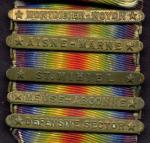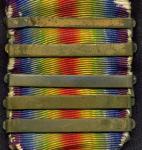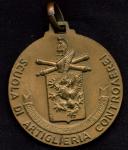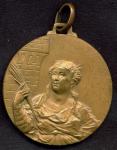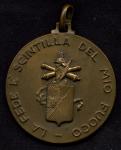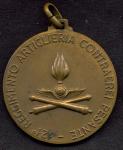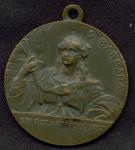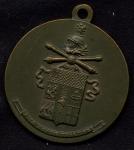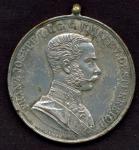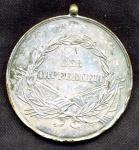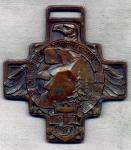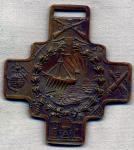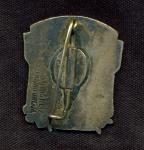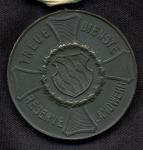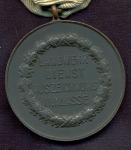-
Posts
5,629 -
Joined
-
Last visited
Content Type
Profiles
Forums
Blogs
Gallery
Events
Store
Everything posted by IrishGunner
-

Italy Italy - Artillery regiment medals
IrishGunner replied to IrishGunner's topic in Southern European & Balkan States
And now for something more interesting perhaps... A WWI regimental commemorative for the 25. Artillery Regiment. The reverse of the medal lists the regiment's battles... -

American (US) Victory Medals
IrishGunner replied to Kev in Deva's topic in Inter-Allied Victory Medals of the Great War
My pride among my US Victory Medals... A 5-bar to the 1st Infantry Division; Montdidier-Noyon, Aisne-Marne, St. Mihiel, Meuse-Argonne, Defensive Sector -

Italy Italy - Artillery regiment medals
IrishGunner replied to IrishGunner's topic in Southern European & Balkan States
And the Anti-Aircraft Artillery School Prior to 1997; In 1997, la "Scuola di Artiglieria Controaerei" changed it's name to Centro Addestramento e Sperimentazione Artiglieria Controaerei -

Italy Italy - Artillery regiment medals
IrishGunner replied to IrishGunner's topic in Southern European & Balkan States
121. Reggimento Artiglieria Controaerei Pesante 121st Anti Aircraft Artillery Regiment... Dates from 1953-1970 when the regiment was garrisoned in Bologna; during that time armed with Ansaldo 90/53 90mm AA cannon -

Italy Italy - Artillery regiment medals
IrishGunner posted a topic in Southern European & Balkan States
I bought these at a flea market in Lucca, Italy during a family vacation 10 years ago. These continue an Italian Army tradition of regimental medals dating, to my knowledge, at least back to WWI. First up... 33. Regimento Artiglieria "Folgore" ... I believe this medal dates from the regiment's assignment to the Folgore Mechanized Division 1947-1975 -
I'm sure it's just me...but things seem very quiet around here since the holidays.
-
A 1941 publication, "Encyclopedia of United States Army Insignia and Uniforms" by Emerson has given the best information I've found for WWI enlisted collar discs. The discs came into use in 1910 and many "unofficial" versions existed. I, of course, know most about artillery, which at first had only two Quartermaster specified discs; one with the crossed cannons centered "high" for Coast Artillery and crossed cannons centered "low" for Field Artillery. Anything with regimental numbers or battery letters were "unofficial" (some would say "unauthorized"). And types even varied between manufacturers. Throughout the following years, especially in 1917-18, the regulations changed frequently. In fact, the 1917 National Geographic article referenced in the post above pictured several insignia that weren't "authorized" until almost a year after the magazine was published. Also, by 1917, the crossed cannons were centered for Field Artillery and the familiar "shell" added to the center of Coast Artillery cannons. In 1918, the regimental numbers were added to the "US" collar disc; meaning a "US" with a "3" could be issued to 3rd Infantry, 3rd Cavalry, etc. Then the company/troop/battery would be on the branch insignia disc. To make things even more interesting, during WWI, there were US discs with "V" for Volunteers; with a "NG" for National Guard; with a "R" for Reserves; with a "NA" for National Army (the "draft" army as different from the Regular Army or the federalized National Guard). Adding to what was suggested above, the regulations changed so quickly and so many soldiers didn't want to spend the cash to buy new insignia; they continued to wear what they already had, were issued or even what they wanted. Here are a pair of generic cannons and a National Army US disc...from 1917-18 (the discs became gilt in 1918).
-

Austria-Hungary Austrian Bravery Medals - Tapferkeitmedaille
IrishGunner replied to Tim B's topic in Austro-Hungarian Empire
Last summer, I picked up this Silberne Tapferkeitsmedaille Franz Josef I, 1. Kl. at an antique market; the dealer thought it was the "bronze" Bravery Medal because it's stamped "BRONZE" on the rim near the suspension loop and it was priced low accordingly. However, it's larger size should have been a give-away that it isn't the smaller bronze or even the 2. Class silver version. It's actually, a post-war silver-plated bronze First Class Tapferkeit... The larger size and the "BRONZE" stempel are give aways to this class and version. -
A post-war badge... Luitpold Kanonier-Tag 1922 Both bFAR 1 and bFAR 7 were named in honor of Prinz-Regent Luitpold. And both were garrisoned in Munich. So, I wonder if this badge is related to those veterans... I did find in Google reference to a short documentary film made about Luitpold Kanonier-Tag 1922, but couldn't find anything in detail or images.
-
Great idea... I look forward to seeing a lot of different perspectives. I know British newspapers and the BBC have a lot already published. It hasn't kicked in yet here in the US. So, I hope our European members share what's in their news - then and now.
-
Yes, interesting and timely. I've posted similar articles in the new WWI Centenary Forum created by Nick.
-
This is a good article from Sunday's Jan 5 2014 edition of The Observer... January 1914: suffragettes, blizzards, exploration – but no hint of war "Yet in January 1914 Europe seemed to be enjoying a period of relative calm. The Balkan wars, during which states including Bulgaria, Greece and Serbia fought for their independence from the Turkish Ottoman empire, appeared to have drawn to a close. The Peace Palace had recently opened in The Hague "for the peaceful settlement of differences between peoples" and Kaiser Wilhelm of Germany was being hailed as a glorious peacemaker with 25 conflict-free years of rule behind him." In the US, the New York Times on 6 January 1914 had more about the situation in Mexico than in Europe; but this little bit about the Kaiser's "feud" with the "Crown Prince" is interesting. According to the Berliner Zeitung, it seems the Crown Prince was stripped of his command of the Death's Head First Hussars for comments supporting the Zabern, Alsace affair. He'll be back in command by summer, I'm sure... The Telegraph compared Britain's naval power with Germany, Italy, and Austria-Hungary on page 12 of it's 6 Jan 1914 edition, concluding, "It is still true that the Navy is our - all in all." Even Old Age Pensions depend it seems on a strong Royal Navy. I think the Navy should enjoy it's reign at the top for another six months, because the Tommy in the trenches is soon to become Britain's "all in all." The calm before the storm as it were...
-
Another big gun... The Eisenbahn Kanone - 38 cm Schnellladen Kanone (SK) L/45 "Max" These were originally intended to be naval guns on ships, but many were adapted for land use, first in concrete/metal emplacements and then later on rail cars. As you can see from the caption, this one was destroyed/captured by the Australians near Amiens. I suspect the photo was taken after the war.
-
Starting to catalog a lot of stuff I "accumulated" last year... Picked this up last summer at a West Virginia flea market...just happens to be a 12-inch gun, Model 1888, on a Watertown Arsenal Barbette Carriage Model 1892. 66 of these were produced. The one in my photo is at Battery Godfrey, Presidio of San Francisco about 1910. These guns remained in service until 1943. Posted to Ohio from a soldier in the 45th Company; San Francisco; 2nd Prov. Reg. CAC.
-
I picked this one up a several months ago simply because I like the way it looks. Too bad it's not a military award. It's the Annerkennungs-Medaille der König-Karl-Jubiläums-Stiftung. Recognition Medal of the King Karl Jubilee Foundation; 1893-1921. The Jubilee Foundation was created in 1891 on the occasion of the jubilee of König-Karl under the direction of the Interior Ministry to improve the welfare of the rural poor and to support small businesses. Two years later, in 1893, the medal was instituted by König Wilhelm II to recognize long and faithful service to the Foundation.









